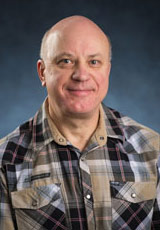Dennis Tokaryk

Professor, Dept. Chair
PhD
I.U.C. Physics/Admin 211
Fredericton
Laser spectroscopy and far-infrared synchrotron spectroscopy of gas-phase molecules
My research examines the structure of molecules in the gas phase by exposing them to laser light or synchrotron light. The wavelengths of the light emitted or absorbed by the molecules are then interpreted to reveal the details of their internal physics – their structure, how they vibrate and rotate, and how their electrons interact with their nuclei, for example. I principally study molecules that are of interest in astrophysics, and that can help answer questions about the nature of the fundamental particles from which matter in the universe is composed.
The laboratory at UNB boasts a wide range of lasers that provide light in the visible and near-infrared parts of the spectrum. My collaborators (Drs. Allan Adam (Chemistry, UNB) and Colan Linton (Physics Emeritus, UNB)) and I are specialists in the creation and study of small molecules containing a metal atom, either in a fast-moving molecular jet or by warming metal in a specialized oven then reacting it with a variety of gases.
I also conduct experiments on the far-infrared beamline at the Canadian Light Source (CLS) synchrotron, where I probe larger molecules with the intense and highly collimated beam that the facility provides. This research focuses on the rotations and vibrations of the molecules, which we can study with exceptional sensitivity and precision.
Molecules of astrophysical interest
Most of the information we gather about the chemical content of comets, stellar atmospheres, planetary nebula, and even the interstellar medium comes from the light emitted or absorbed by the atoms and molecules in these environments. The light pattern is unique to each molecule, and identifies the species and its abundance. We study molecules like triatomic carbon (C3), iron hydride (FeH), magnesium hydride (MgH), magnesium acetylides (MgC2H, MgC4H), and related species so that astronomers have reliable information to make identifications.
At the CLS, we have studied many 9- and 10-atom molecules that form rings of carbon atoms, often with oxygen, nitrogen, or sulphur atoms mixed in. These systems, and more complex structures in which they form a part, are now either conclusively identified in astrophysical bodies or are strong contenders for identification.
Molecules as probes of fundamental particles
Metal-bearing species like ytterbium fluoride (YbF) and ytterbium hydroxide (YbOH) are ‘molecule-sized laboratories’ in which very subtle properties of subatomic particles can be probed. Once such property is the electric dipole moment (EDM) of the electron, which is predicted to be exceedingly small and is very difficult to measure. Before the molecular laboratories can be used, they must be studied and understood. Our group’s expertise fits perfectly with these studies since we have decades of experience in making the required metal-bearing molecules, as well as in collecting their spectra and interpreting them.
